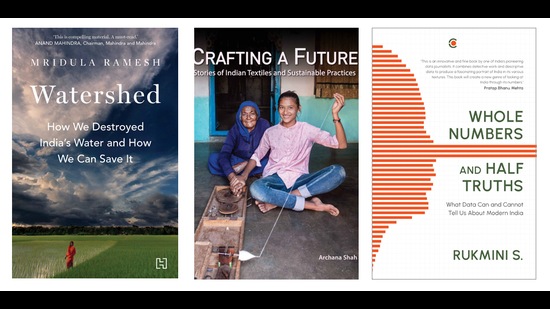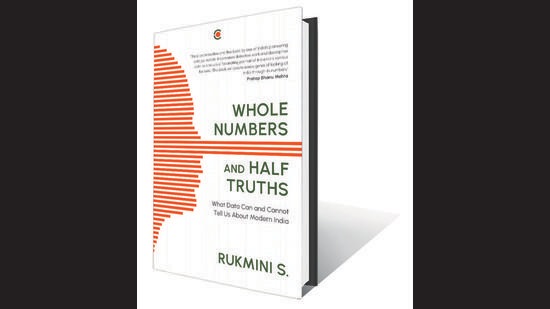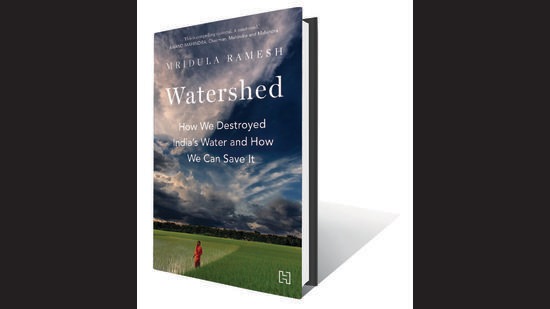HT Picks; New Reads
On the reading list this week is a book that looks at what data tells us about the lives, beliefs and attitudes of contemporary Indians, another that presents how water-related extremes will shape our future, and a volume that celebrates India’s tradition of handcrafted textiles
What data can and cannot tell us about modern India


How do you see India? Fuelled by a surge of migration to cities, the country’s growth appears to be defined by urbanization and by its growing, prosperous middle class. It is also defined by progressive and liberal young Indians who vote beyond the constraints of identity, and paradoxically, by an unchecked population explosion and rising crimes against women.
Is it, though?
In 2020, the annual population growth was down to under 1 per cent. Only 31 of 100 Indians live in a city today and just 5 per cent live outside the city of their birth. As recently as 2016, only 4 percent of young, married respondents in a survey said their spouse belonged to a different caste group. Over 45 per cent of voters said in a pre-2014 election survey that it was important to them that a candidate of their own caste wins elections in their constituency. A large share of reported sexual assaults across India are actually consensual relationships criminalized by parents. And staggeringly, spending more than ₹8500 a month puts you in the top 5 per cent of urban India.
In Whole Numbers and Half Truths, data journalism pioneer Rukmini S draws on nearly two decades of on ground reporting experience to piece together a picture that looks nothing like the one you might expect. There is a mountain of data available on India but it remains opaque, hard to access and harder yet to read, and it does not inform public conversation. Rukmini marshals this information, some of it never-before reported, alongside probing interviews with experts and ordinary citizens to see what the numbers can tell us about India. As she interrogates how data works, and how the push and pull of social and political forces affect it, she creates a blueprint to understand the changes of the last few years and the ones to come – a toolkit for India.*
How we destroyed India’s water and how we can save it

India is facing its worst water crisis ever, and some believe that by 2030 it will fail to meet half its water demand. Water availability per person in India has been decreasing for decades, leaving parts of the country in a cruel Day Zero situation, shuttering factories and pushing farmers over the brink. As the climate heats up, it is likely that swathes of land will be submerged, water-related extremes will reshape industry and famine will revisit the country.
In this fascinating, deeply-researched book, Mridula Ramesh takes us through 4000 years of history to track how India’s water has reached this critical point. From stories of ancient water-engineering marvels in the Indus Valley and Tamil Nadu to how water shaped medieval Delhi; from the burning fields of the country’s north-west to the hilsa’s curtailed journey; and from the forest of Kanha and dams in Arunachal to Kanpur’s tanneries, Watershed uncovers how India’s fate is gradually being sealed by the extremes of drought and floods.
Armed with this understanding, Mridula Ramesh lays out pragmatic, scalable solutions that can work for both India’s temperamental water and its democratic exigencies. She describes how determined water warriors are showing the way forward – from the fields of Bihar and Maharashtra to communities within Bengaluru’s apartments and in the arid tracts of Rajasthan – and asserts that managing our water will usher in not just resilience but also the jobs India needs.*
Stories of Indian Textiles and Sustainable Practices

Crafting a Future is a heartfelt celebration of artisans and their vocational skills. Each region in India has its own distinctive raw material, craft techniques, textiles, motifs and colour palettes, and through her well-researched narrative enriched with numerous stories, Archana Shah demonstrates the diversity and true value of handcrafted textiles processes. She believes that handspun, handwoven fabrics made using indigenous fibres and natural material for dyeing will help create a unique identity for handcrafted textiles, and suggests way to repurpose the abundant artisanal talent available across the country to rejuvenate this sector These tenets are woven throughout the book, which is broadly divided into three sections based on natural fibres: cotton from plants, silk from insects and wool from animals. This resonates with Gandhiji’s concept of developing khadi and village industries to rejuvenate the rural economy, and stimulate development through a bottom-up approach.
Beyond its beauty and heritage value, artisanal production is eco friendly, has a negligible carbon footprint and fulfils most of the United Nations’ Sustainable Development Goals (SDGz). It has the potential for creating dignified employment opportunities for millions of people in their own regional location, so that they are not compelled by economic constraints to abandon their ancestral professions and migrate to urban slums to earn a meagre livelihood as unskilled labourers. In essence, the book focuses on artisans, their aspirations and fulfilment in their work. It also draws upon their traditional wisdom to address two of the most serious challenges that we face today: growing unemployment and climate change.*
*All copy from book flap.



